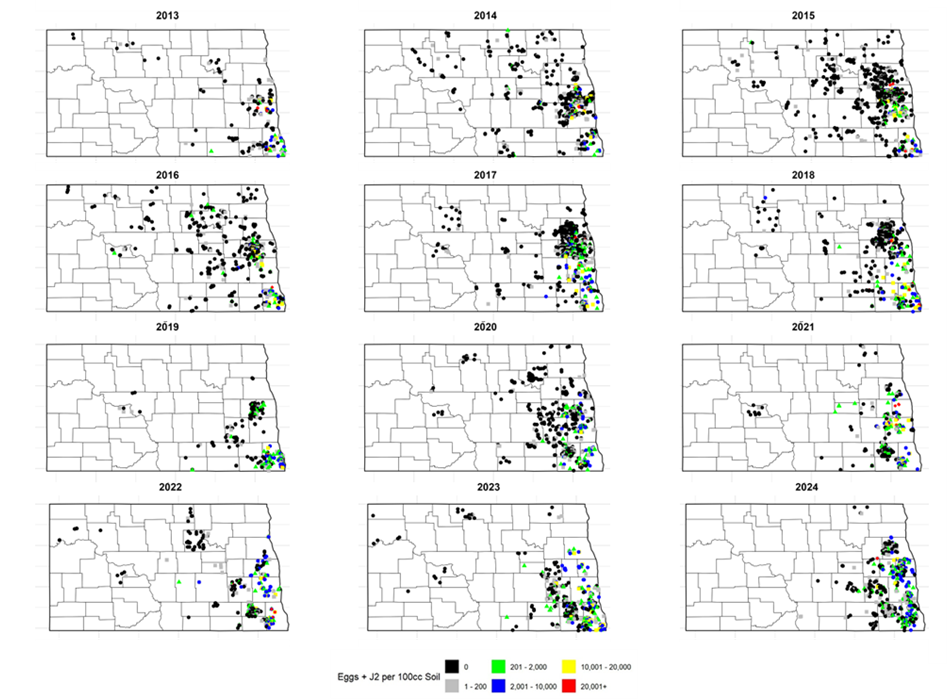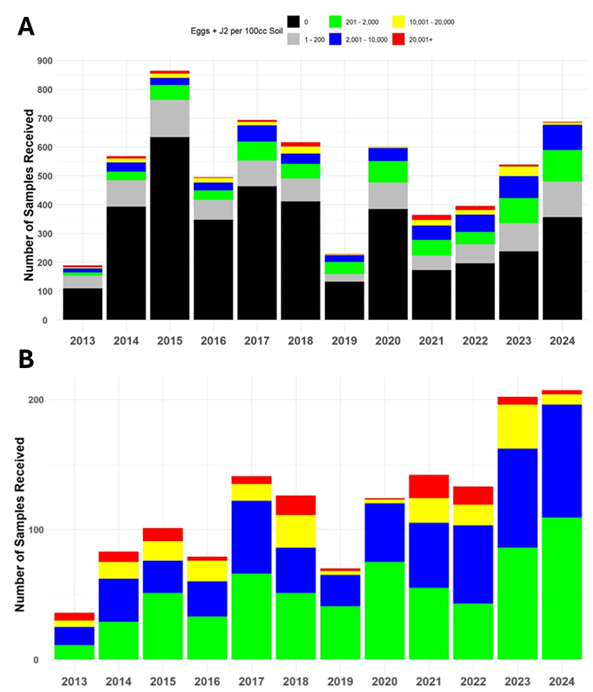Summary of Soybean Cyst nematode Survey: 2013-2024 (4/17/2025)
SCN Sampling Program: 2013-2024
Between 2013 and 2024, the NDSC-supported SCN sampling program, operated by NDSU Extension, has facilitated the submission of 6,237 soil samples by North Dakota soybean farmers. These samples, collected primarily in the fall after harvest, have been analyzed for SCN egg counts, expressed as eggs per 100 cubic centimeters (cc) of soil (approximately 3.3 ounces). The program offers free sampling kits and covers laboratory fees, encouraging widespread participation to monitor SCN’s spread and impact.

Figure 1. Number of SCN samples received from the NDSU SCN sampling program.
This figure maps the geographic distribution of the 6,237 samples, showing where SCN testing has been concentrated across North Dakota’s soybean-growing regions. The majority of sampling conducted has been present in Eastern ND, while much of Western ND has been under sampled leading to the false appearance of SCN not being prevalent.

Figure 2. SCN samples collected each year from 2013 to 2024 across the state of North Dakota.
This figure illustrates the annual breakdown of sample submissions, highlighting trends in grower participation and sampling efforts over the 12-year period. A) The top figure represents all submitted samples, while B) represents all samples with reported levels of SCN greater than 201 eggs + J2 per 100cc of soil.
SCN Biology and Impact
SCN (Heterodera glycines) is a microscopic, parasitic nematode that feeds on soybean roots, reducing yield by impairing water and nutrient uptake. Each female SCN produces 100–300 eggs, which are encased in a cyst which is the female body after she dies. These cysts protect the eggs, allowing them to persist in the soil for years and hatch into juveniles that reinfect soybean roots. In our region, SCN typically completes two to three life cycles per growing season, increasing its population rapidly when soybeans are planted repeatedly over a period of a few years. Yield losses can occur without visible above-ground symptoms, making soil sampling the most reliable detection method.
Distribution and Egg Levels in North Dakota
Results from the 6,237 samples indicate that SCN has been identified in 25 counties across North Dakota. From this, SCN has been most prevalent and at higher levels in the southeastern and east-central parts of North Dakota, particularly in counties like Richland, Cass, and Sargent. These areas consistently show higher egg counts, reflecting established infestations. SCN has also been detected in additional counties, though less frequently and with lower egg levels, suggesting ongoing spread. However, sampling of SCN is much lower across the central and western soybean-growing regions of the state, where fewer samples have been collected. As a result, the understanding of SCN distribution in these areas is not as well understood, and sampling efforts need to be further improved to better map the nematode’s presence and guide management decisions. The program’s data reveal that while some fields remain SCN-free, the nematode’s footprint has expanded since 2013, indicating continued vigilance.
Management Insights from Sampling
For growers with known SCN infestations, sampling provides a way to evaluate management effectiveness. Stable or declining egg counts suggest that strategies like resistant varieties (e.g., PI 88788 or Peking sources) and crop rotation with non-hosts (e.g., corn, wheat) are working. Rising egg levels, however, signal the need for adjustments in management plans, such as diversifying resistance sources or extending rotation periods. Recent research highlights SCN’s increasing adaptation to the widely used PI 88788 resistance, urging farmers to explore alternatives such as Peking derived soybean varieties or nematicide seed treatments under certain conditions.
Recommendations and Resources
The NDSC and NDSU Extension continue to support the SCN sampling program in 2025. Growers are encouraged to sample fields this fall, before or after harvest, using free kits available at your local county Extension offices. The SCN Coalition (www.thescncoalition.com) also offers videos, sampling protocols, and management strategies from a national public-private partnership.
Wade Webster, Extension Soybean Pathologist, NDSU
701-231-7057
Guiping Yan, Nematologist, NDSU
Updated: April 2025
